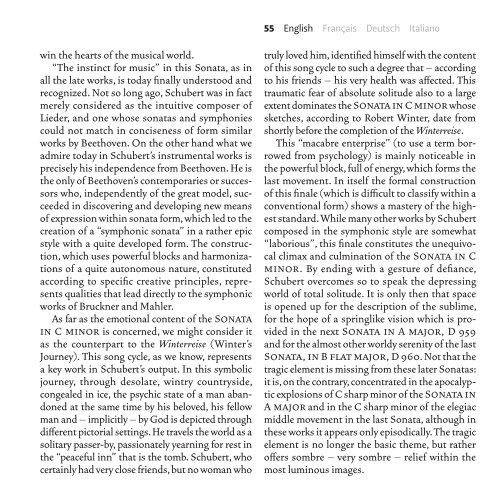Télécharger le livret - Outhere
Télécharger le livret - Outhere
Télécharger le livret - Outhere
Create successful ePaper yourself
Turn your PDF publications into a flip-book with our unique Google optimized e-Paper software.
win the hearts of the musical world.<br />
“The instinct for music” in this Sonata, as in<br />
all the late works, is today finally understood and<br />
recognized. Not so long ago, Schubert was in fact<br />
merely considered as the intuitive composer of<br />
Lieder, and one whose sonatas and symphonies<br />
could not match in conciseness of form similar<br />
works by Beethoven. On the other hand what we<br />
admire today in Schubert’s instrumental works is<br />
precisely his independence from Beethoven. He is<br />
the only of Beethoven’s contemporaries or successors<br />
who, independently of the great model, succeeded<br />
in discovering and developing new means<br />
of expression within sonata form, which <strong>le</strong>d to the<br />
creation of a “symphonic sonata” in a rather epic<br />
sty<strong>le</strong> with a quite developed form. The construction,<br />
which uses powerful blocks and harmonizations<br />
of a quite autonomous nature, constituted<br />
according to specific creative princip<strong>le</strong>s, represents<br />
qualities that <strong>le</strong>ad directly to the symphonic<br />
works of Bruckner and Mah<strong>le</strong>r.<br />
As far as the emotional content of the Sonata<br />
in C minor is concerned, we might consider it<br />
as the counterpart to the Winterreise (Winter’s<br />
Journey). This song cyc<strong>le</strong>, as we know, represents<br />
a key work in Schubert’s output. in this symbolic<br />
journey, through desolate, wintry countryside,<br />
congea<strong>le</strong>d in ice, the psychic state of a man abandoned<br />
at the same time by his beloved, his fellow<br />
man and – implicitly – by God is depicted through<br />
different pictorial settings. He travels the world as a<br />
solitary passer-by, passionately yearning for rest in<br />
the “peaceful inn” that is the tomb. Schubert, who<br />
certainly had very close friends, but no woman who<br />
55 English Français Deutsch Italiano<br />
truly loved him, identified himself with the content<br />
of this song cyc<strong>le</strong> to such a degree that – according<br />
to his friends – his very health was affected. This<br />
traumatic fear of absolute solitude also to a large<br />
extent dominates the Sonata in C minor whose<br />
sketches, according to Robert Winter, date from<br />
shortly before the comp<strong>le</strong>tion of the Winterreise.<br />
This “macabre enterprise” (to use a term borrowed<br />
from psychology) is mainly noticeab<strong>le</strong> in<br />
the powerful block, full of energy, which forms the<br />
last movement. in itself the formal construction<br />
of this fina<strong>le</strong> (which is difficult to classify within a<br />
conventional form) shows a mastery of the highest<br />
standard. Whi<strong>le</strong> many other works by Schubert<br />
composed in the symphonic sty<strong>le</strong> are somewhat<br />
“laborious”, this fina<strong>le</strong> constitutes the unequivocal<br />
climax and culmination of the Sonata in C<br />
minor. By ending with a gesture of defiance,<br />
Schubert overcomes so to speak the depressing<br />
world of total solitude. it is only then that space<br />
is opened up for the description of the sublime,<br />
for the hope of a springlike vision which is provided<br />
in the next Sonata in A major, D 959<br />
and for the almost other worldy serenity of the last<br />
Sonata, in B flat major, D 960. Not that the<br />
tragic e<strong>le</strong>ment is missing from these later Sonatas:<br />
it is, on the contrary, concentrated in the apocalyptic<br />
explosions of C sharp minor of the Sonata in<br />
A major and in the C sharp minor of the e<strong>le</strong>giac<br />
midd<strong>le</strong> movement in the last Sonata, although in<br />
these works it appears only episodically. The tragic<br />
e<strong>le</strong>ment is no longer the basic theme, but rather<br />
offers sombre – very sombre – relief within the<br />
most luminous images.


